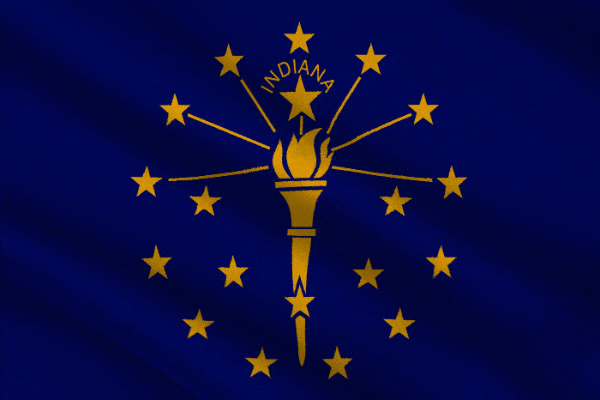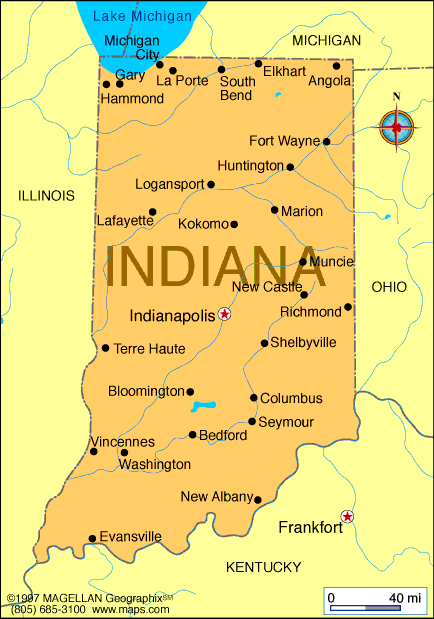Indiana

Indiana State Facts
Entered Union: December 11, 1816 (19th State)
Organized as territory: May 7, 1800
Present constitution adopted: 1851
Fun Facts
State abbreviation/Postal code: Ind./IN
Nicknames: Hoosier State
Origin of name: "Land of Indians" in new Latin.
Motto: "The Crossroads of America"
Slogan: "Honest to Goodness Indiana"
State symbols:
Bird: Cardinal (1933)
Insect: Say's firefly (2018)
Flower: Peony (1957)
Tree: Tulip tree (1931)
River: Wabash River (1996)
Soil: Miami
Stone: Limestone (1971)
Colors: Blue and Gold
Holidays: George Rogers Clark Day — 2/25; Northwest Ordinance Day — 7/13; Indiana Day — 12/11.
Pie: Sugar Cream Pie (2009)
Poem: "Indiana" by Arthur F. Mapes (1963)
Song: "On the Banks of the Wabash Far Away" (1913)
Rifle: Grouseland Rifle (2012)
Government
Capital: Indianapolis
Official language: English
State Website: www.in.gov
Governor: Eric Holcomb, R (to Jan. 2021)
Lieut. Governor: Suzanne Crouch, R (to Jan. 2021)
Secy. of State: Connie Lawson, R (to Jan. 2019)
Treasurer: Kelly Mitchell, R (to Jan. 2019)
Atty. General: Curtis Hill, R (to Jan. 2021)
U.S. Representatives: 9
Senators: Todd C. Young, R (to Jan. 2023); Joseph Donnelly, Sr. , D (to Jan. 2019)
See Also: Historical biographies of West Virginia Congress members
Population
Residents: Hoosier
Resident population: 6,666,818 (17th Largest State, 2016)
10 largest cities (2010): Indianapolis, 834,852; Fort Wayne, 254,555; Evansville, 120,235; South Bend, 100,800; Carmel, 83,565; Bloomington, 81,963; Fishers, 81,833; Hammond, 79,686; Gary, 79,170; Muncie, 70,087
Race/Ethnicity: White (84.3%); Black (9.1%); American Indian (0.3%); Asian (1.6%); Other race (2.4%); Two or more races (2.0%); Hispanic/Latino (6.0%).
Religion: Protestant (52%); No religion/Unaffiliated (26%); Catholic (18%); Mormon (1%); Jewish (1%); Other (2%).
Sex: Male (49.2%); Female (50.8%).
Age: Under 18 (24.8%); 18-64 (62.4%); 65 and over (12.8%). Median Age: 37
See Also: Additional Indiana Census Data
Economy
GDP: 359 billion dollars (16th in U.S., 2017)
Unemployment: 3.4% (2015)
Overview: Indiana has remained one of America's strongest manufacturing states. The state has the highest percentage of laborers employed in manufacturing; it is a leading producer of steel, heavy machinery, and automotive parts. It also has notable mining and energy sectors, though like the rest of the country it has seen a large growth in service industries in the last two decades.
Geography
Land area: 35,867 sq mi. (92,896 km2)
Geographic center: In Boone Co., 14 mi. NNW of Indianapolis
Number of counties: 92
Largest county by population and area: Marion, 918,887 (2014); Allen, 657 sq mi.
State historic sites: 17 (2,007 ac.)
State parks/recreation areas: 23 (56,409 ac.)
Area codes
Tourism office
See more on Indiana:
Encyclopedia: Indiana
Encyclopedia: Geography
Encyclopedia: Economy
Encyclopedia: Government
Encyclopedia: History
Monthly Temperature Extremes
Indiana State History
Like other Midwest states, Indiana has a very long archaeological record. Native peoples lived in the Midwest going back over 15,000 years, covering many different major cultural shifts. In the 1000s, as in neighboring Kentucky, Indiana was home to Mississippian and Fort Ancient cultures. The most famous local nations were the Chickasaw, Lenape, Wyandot, Cherokee, and Shawnee.
Indiana was first explored by the French, including Robert Cavelier, Sieur de la Salle who explored Kentucky. was thoroughly explored by the French in the 1600 and 1700s, where they established a military and economic presence. In 1679-1680, the region figured importantly in the Franco-British struggle for North America that culminated with British victory in 1763. George Rogers Clark led American forces against the British in the area during the Revolutionary War and, prior to becoming a state, Indiana was the scene of frequent Native American uprisings until the victories of Gen. Anthony Wayne at Fallen Timbers in 1794 and Gen. William Henry Harrison at Tippecanoe in 1811.
During the 19th century, Indiana was the site of several experimental communities, including those established by George Rapp and Robert Owen at New Harmony.
During the gilded age, Indiana became a massive industrial state. Indiana's 41-mile Lake Michigan waterfront is, even today, "one of the world's great industrial centers," turning out iron, steel, and oil products. The industry in Indiana played a big role in the growth of the American automotive industry. The region suffered like the rest of the country during the Great Depression, but the established industry in Indiana led the state to major gains after World War II.
Vice President Mike Pence - who grew up in Indiana - served as Governor of Indiana for four years.
Wyandotte Cave, one of the largest in the U.S., is located in Crawford County in southern Indiana, and West Baden and French Lick are well known for their mineral springs. Other attractions include Indiana Dunes National Lakeshore, Indianapolis Motor Speedway, Lincoln Boyhood National Memorial, and the George Rogers Clark National Historical Park.
Indiana Culture and Interesting Facts
College Sports
Indiana has a deep sports legacy. The Indiana Hoosiers are a high-performing college basketball team with a die-hard fanbase. Basketball in general is a big deal in Indiana; the hype and buzz surrounding the sport led to the coining of the term "Hoosier Hysteria." This love of basketball clearly pays off, as Indiana produces the most NBA players per capita. College football is also big; although football is most often associated with the South, some of the nation's most popular and most successful college football teams are from Indiana. The Notre Dame Fighting Irish are the most famous of these.
The Indy 500
Indiana is also home to, arguably, the biggest auto-racing event in the world. The Indy 500 is the largest single day sporting event in the world attracting up to 300,000 attendees. Not only is it big, it's prestigious. The Indy 500 is considered part of the "Triple Crown of auto-racing," along with the 24 Hours of Le Mans and the Monaco Grand Prix. Motorsports in general became popular in Indiana probably due to the large number of car manufacturers in the state. The race has been a yearly occurrence since 1911. It's accrued a lot of ritual and ceremony over time, and now the pre- and post-race rituals are an indispensable part of the experience. The most peculiar tradition at Indy is that almost every year for the last eighty years the winner drinks a large bottle of milk. In 2016, the race organizers offered the attendees their own bottles of milk to toast the winner.
The Hoosier State
Hoosiers, as enshrined in their college basketball team, are big fans of being Hoosiers. It's their official demonym, and it's in their state nickname. The only rub is that nobody knows what exactly a Hoosier is. The origin of the word is a mystery that scholars have been trying to solve for over a century. Some popular theories include that it comes from the name of a famous black preacher, Reverend "Black Harry" Hosier, and that it was customary to call out "Who's here?" when guests arrived (becoming "Hoosier" with a rural Indiana accent). State poet laureate James Whitcomb Riley jokingly claimed it came from the amount of brawling (and biting) among Indiana men, prompting the regular question of "Whose ear?"
Mother of Vice Presidents
A couple states compete for the title of "Mother of Presidents," but Indiana makes the more unique claim as "Mother of Vice Presidents." The state has produced a disproportionate number of vice presidents—six, more than any other state except New York. Only two major-party VP candidates from Indiana have ever lost, being on the tickets of William Jennings Bryan and Winfield Hancock.
Famous Indiana Natives and Residents
Theodore Dreiser writer;
Bernard F. Gimbel merchant;
Virgil Grissom astronaut;
Phil Harris actor and band leader;
John Milton Hay statesman;
James R. Hoffa labor leader;
Michael Jackson singer;
Buck Jones actor;
Alfred C. Kinsey zoologist and sexologist;
David Letterman TV host and comedian;
Carole Lombard actress;
Shelley Long actress;
Marjorie Main actress;
James McCracken tenor;
Steve McQueen actor;
Joaquin Miller poet;
Paul Osborn playwright;
Cole Porter songwriter;
Ernest Taylor Pyle journalist;
J. Danforth Quayle former vice president;
James Whitcomb Riley poet;
Knute Rockne football coach;
Ned Rorem composer;
Red Skelton comedian;
Rex Stout mystery writer;
Booth Tarkington author;
Twyla Tharp dancer and choreographer;
Forrest Tucker actor;
Harold C. Urey physicist;
Kurt Vonnegut, Jr. author;
Jessamyn West novelist;
Wendell Willkie lawyer;
Wilbur Wright inventor.
U.S. State Comparisons
Population & Economy
Historical Population Statistics, 1790–Present
Per Capita Personal Income
Minimum Wage Rates
State Taxes
Federal Government Expenditure
Percent of People in Poverty
Births and Birth Rates
Homeownership
Percentage of Uninsured by State
Society & Culture:
Most Livable States
Healthiest States
Most Dangerous States
Smartest States
Crime Index
Residency Requirements for Voting
Compulsory School Attendance Laws
Driving Laws
Geography & Climate
Record Highest Temperatures
Record Lowest Temperatures
Highest, Lowest, and Mean Elevations
Land and Water Area

